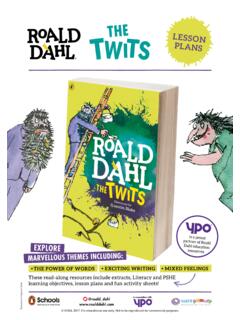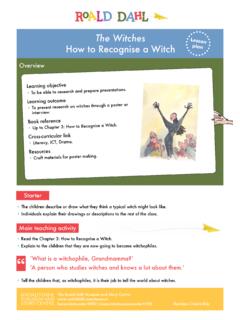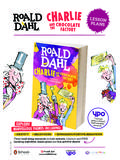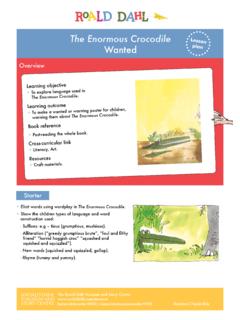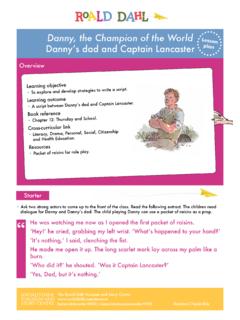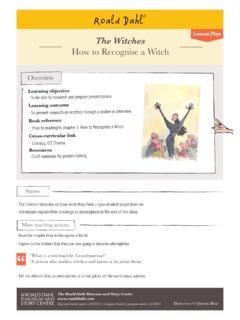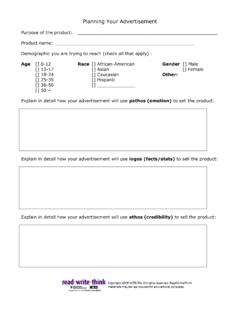Transcription of LESSON PLANS - Roald Dahl
1 EXCITING WRITINGT hese read-along resources include extracts, Literacy and PSHE learning objectives, LESSON PLANS and fun activity sheets!Illustrations Quentin Blake THE POWER OF WORDS MIXED FEELINGSLESSON PLANSMARVELLOUS THEMES INCLUDING:EXPLOREis a proud partner of Roald Dahl education @roald_dahlIn association with RDNL 2017. For educational use only. Not to be reproduced for commercial Quentin @roald_dahlIn association with2 CONTENTSLESSON plan 1: BOOK THEME: The power of wordsLITERACY OBJECTIVE: Identifying alliteration, onomatopoeia and rhyming patterns in Roald Dahl s poetry and exploring their effect on the reader.
2 Writing an original poem, using Roald Dahl s work as a OBJECTIVE: Participating constructively in discussions by making appropriate comments, taking turns and listening to USED: from The Cook up . LESSON plan 2:BOOK THEME: Masters of InventionLITERACY OBJECTIVE: Using alliteration and adverbs effectively. Using persuasive OBJECTIVE: Understanding that commonly available substances and drugs can damage USED: from George Begins to Make the Medicine . LESSON plan 3:BOOK THEME: Exciting writingLITERACY OBJECTIVE: Identifying how Roald Dahl uses language, punctuation and text styles to generate excitement.
3 Writing similes using Roald Dahl s work as a stimulus. Understanding how dramatic techniques bring stories to USED: from Grandma Gets the Medicine . LESSON plan 4:BOOK THEME: RevengeneLITERACY OBJECTIVE: Drawing inferences and justifying them with evidence from the a deep understanding of the character of Grandma and creating an original character profile based upon George s OBJECTIVE: Understanding that revenge has a negative impact on both the perpetrator and the USED: from Grandma LESSON plan 5:BOOK THEME: Sensational storiesLITERACY OBJECTIVE: Identifying and using exciting verbs, adverbs and adjectives.
4 Planning a piece of writing based upon the vocabulary and structure of George s Marvellous OBJECTIVE: Providing, receiving and responding to constructive feedback, recognising and learning from others USED: from Grandma . LESSON plan 6:BOOK THEME: Mixed feelingsLITERACY OBJECTIVE: Drawing inferences about characters feelings, justifying their inferences with evidence from the OBJECTIVE: Understanding what is meant by having conflicting (or mixed ) emotionsIdentifying when to heed emotions and when to try to overcome USED: from Grandma.
5 GEORGE S MARVELLOUS MEDICINE POSTER ACTIVITY SHEETS X 3 INVENTOR S LOG THINGS YOU MAY NEED FOR THESE LESSON PLANSI llustrations Quentin @roald_dahlIn association with3 PREPARATION:Each child will need a copy of both extracts and of each of the three resources. For activity two, you will need to provide each child with a copy of a common tongue twister and each group with a saucepan, a wooden spoon and a selection of revolting ingredients - a smelly sock, a rubber snake, a jar of slime (there are plenty of recipes available on the internet), ACTIVITY: Read extract one.
6 Ask children what George is putting into his medicine. Which adjectives has Roald Dahl used to describe some of the ingredients ? What effect do these adjectives have on us as readers? MAIN TASK: WONDROUS WORDSD ivide children into groups. Set up a carousel of activities in which children investigate how Roald Dahl skilfully manipulates words to achieve extraordinary effects. Activity one: Children read extract one independently, then invite one or two to read it aloud. Which words rhyme? Is there any rhyming pattern to the poem? Prompt them to notice that it s written in rhyming couplets.
7 Why do children think Dahl used rhyming couplets? What effect does this have on the reader? Children should use RESOURCE1: REVOLTING RHYMES to generate new rhyming words for Roald Dahl s ..BOOK THEMES: The power of wordsLESSON OBJECTIVES: Identifying alliteration, onomatopoeia and rhyming patterns in Roald Dahl s poetry and exploring their effect on the reader Writing an original poem, using Roald Dahl s work as a model Participating constructively in discussions by making appropriate comments, taking turns and listening to othersTHINGS YOU MAY NEED FOR THIS LESSON :Poetry writing resources and rhyme games.
8 See page 47 LESSON plan 1 Illustrations Quentin @roald_dahlIn association with4 Activity two: Give children copies of extract one along with some well-known tongue twisters like She sells sea shells on the sea shore , Red lorry, yellow lorry, red lorry, yellow lorry and Peter Piper picked a peck of pickled pepper . Why are these called tongue-twisters? How does the extract compare with the tongue-twisters? Clarify that when words close together start with the same letter or sound it s called alliteration . Why do children think that Roald Dahl used alliteration?
9 Set out a revolting selection of ingredients a smelly sock, a rubber snake, pretend worms, a tray of mud, a jar of slime, a revolting picture of a slug, something hairy and so on together with a saucepan and a spoon. Each child chooses something to drop into the saucepan. As they stir they say the name of their ingredient together with an alliterative adjective: mouldy mud . Extend by asking them for two alliterative adjectives, for example: slippery, sludgy slime . Activity three : Introduce the term onomatopoeia if children don t know it.
10 Ask children to define the word onomatopoeia . Why do they think Roald Dahl has used onomatopoeia in his poem? Ask children to highlight all the noisy (onomatopoeic) words in extract one, then to write down as many noisy words as they can think of to match the pictures on RESOURCE 2: SOUND SCORCERY. DEVELOPING THE ACTIVITY: PERILOUS POTIONSRead extract two, William Shakespeare s Double, double toil and trouble from Macbeth. Examine the poem together so that children understand the context if they are unfamiliar with the play. Discuss which ingredients the witches have thrown into their cauldron, deciphering tricky language.

